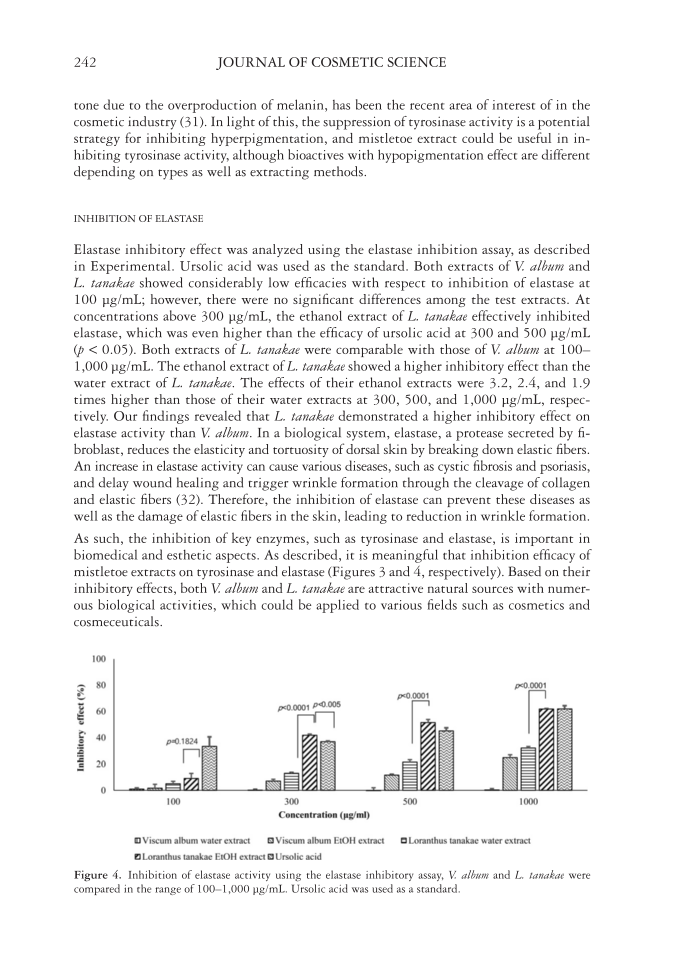ASSESSMENT OF BIOLOGICAL ACTIVITIES OF MISTLETOES FOR COSMETIC APPLICATIONS 241 the ethanol extract of L. tanakae showed a higher absorbance than that from V. album. Fur- thermore, the water extract of L. tanakae showed a higher absorbance than that from V. album. Based on the absorbance, the ethanol extract of L. tanakae showed a similar antioxidant activity to that of ascorbic acid in the range of 300 to 1,000 μg/mL. Ascorbic acid had a marginally higher reducing power but was statistically not signifi cant. Taken together, our results demonstrate that the antioxidant activity depends on the species and extrac- tion conditions. In addition, antioxidant components as well as the phenolic compounds might be present in these extracts, considering the slight differences in the result values. INHIBITION OF TYROSINASE Figure 3 shows th e inhibition of tyrosinas e activity by the mistletoe extracts of V. album and L. tanakae in the range of 100 to 1,000 μg/mL. Each measurement was compared with that of arbutin, a glycosylated hydroquinone-inhibiting tyrosinase, as the standard. The ethanol extracts of both mistletoes inhibited tyrosinase, whereas their water extracts showed no signifi cant inhibition. The ethanol extracts of both mistletoes had a lower inhibitory effect on tyrosinase than arbutin the ethanol extract of V. album showed a higher inhibitory effect. When 1,000 μg/mL of the extract was used, the inhibitory effect was 35.96%, which was similar to the value obtained when arbutin was used at 500 μg/mL. These results show that the ethanol extracts contain more natural compounds with anti- tyrosinase activity (e.g., tyrosinase inhibitor) and the extract of V. album is more effective than that of L. tanakae. In comparison, the water extracts of V. album and L. tanakae did not show any signifi cant effects, whereas their ethanol extracts inhibited tyrosinase. Physiologi- cally, tyrosinase, a glycoprotein in melanosomes, plays an important role in melanogene- sis tyrosinase is involved in the hydroxylation of L -tyrosine to L -dihydroxyphenylalanine (L-DOPA) and the subsequent conversion to L -DOPA-quinone (29). The maintenance of melanogenesis is critical because a high level of tyrosinase activity causes hyperpigmenta- tion disorders, such as melasma, lentigo, and drug/UV-induced hyperpigmentation (30). Even if not diseases, abnormal hyperpigmentation is rarely preferred aesthetically. Skin lightening (in Asia)/brightening (in West), through removal of dark spots or uneven skin Figure 3. Inhibition of tyrosinas e activity using the tyrosinase inhibitory assay, V. album and L. tanakae were compared in the range of 100–1,000 μg/mL. Arbutin was used as a standard.
JOURNAL OF COSMETIC SCIENCE 242 tone due to the overproduction of melanin, has been the recent area of interest of in the cosmetic industry (31). In light of this, the suppression of tyrosinase activity is a potential strategy for inhibiting hyperpigmentation, and mistletoe extract could be useful in in- hibiting tyrosinase activity, although bioactives with hypopigmentation effect are different depending on types as well as extracting methods. INHIBITION OF ELASTASE Elastase inhibitory effect was analyzed using the elastase inhibition assay, as described in Experimental. Ursolic acid was used as the standard. Both extracts of V. album and L. tanakae showed considerably low effi cacies with respect to inhibition of elastase at 100 μg/mL however, there were no signifi cant differences among the test extracts. At concentrations above 300 μg/mL, the ethanol extract of L. tanakae effectively inhibited elastase, which was even higher than the effi cacy of ursolic acid at 300 and 500 μg/mL (p 0.05). Both extracts of L. tanakae were comparable with those of V. album at 100– 1,000 μg/mL. The ethanol extract of L. tanakae showed a higher inhibitory effect than the water extract of L. tanakae. The effects of their ethanol extracts were 3.2, 2.4, and 1.9 times higher than those of their water extracts at 300, 500, and 1,000 μg/mL, respec- tively. Our fi ndings revealed that L. tanakae demonstrated a higher inhibitory effect on elastase activity than V. album. In a biological system, elastase, a protease secreted by fi - broblast, reduces the elasticity and tortuosity of dorsal skin by breaking down elastic fi bers. An increase in elastase activity can cause various diseases, such as cystic fi brosis and psoriasis, and delay wound healing and trigger wrinkle formation through the cleavage of collagen and elastic fi bers (32). Therefore, the inhibition of elastase can prevent these diseases as well as the damage of elastic fi bers in the skin, leading to reduction in wrinkle formation. As such, the inhibition of key enzymes, such as tyrosin ase and elastase, is important in biomedical and esthetic aspects. As described, it is meaningful that inhibition effi cacy of mistletoe extracts on tyrosinase and elastase (Figures 3 and 4, respectively). Based on their inhibitory effects, both V. album and L. tanakae are attractive natural sources with numer- ous biological activities, which could be applied to various fi elds such as cosmetics and cosmeceuticals. Figure 4. Inhibition of elastase act i vity using the elastase inhibitory assay, V. album and L. tanakae were compared in the range of 100–1,000 μg/mL. Ursolic acid was used as a standard.
Purchased for the exclusive use of nofirst nolast (unknown) From: SCC Media Library & Resource Center (library.scconline.org)


















































